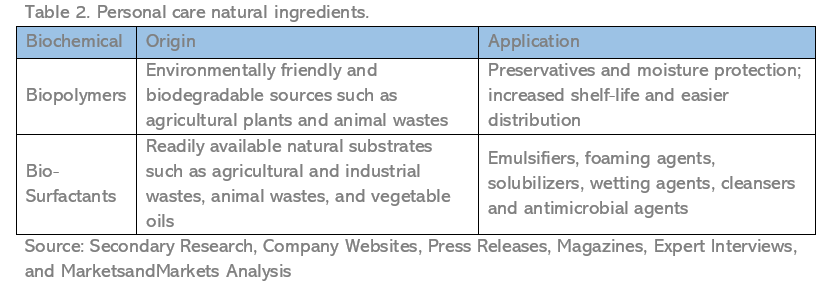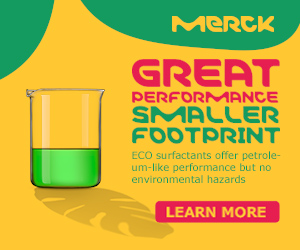Cosmetics & Personal Care
Market trends in cosmetics and personal care ingredients 7th October 2019
By Markets&Markets
The experts at Markets&Markets share insights from their research into the cosmetics and personal care market, with a focus on
The experts at Markets&Markets share insights from their research into the cosmetics and personal care market, with a focus on North America, where the personal care ingredients market is projected to reach $3,440 million by 2024.
Emollients and surfactants are the most common ingredients in hair, skin, and oral products and toiletries. Emollients, which help prevent and treat dry skin, protect sensitive skin, and improve skin tone and texture, are used in various personal care products, such as soaps, moisturizing creams, ointments, lotions and shower gels. Surfactants, on the other hand, are used in soaps, shampoos, and shower gels to create foam and lather, which help remove excess oils from the skin. Conditioning polymers, hair conditioners and fixatives, antimicrobials and fragrances are also common ingredients, and there is a plethora of active ingredients, such as whitening agents, anti-aging agents, and UV absorbers catering to specific skin needs.
The personal care ingredients market1 in North America is projected to reach $3,440 million by 2024, growing at a compound annual growth rate (CAGR) of 2.8% between 2019 and 2024. Increased beauty consciousness and a wider availability of advanced products (e.g. anti-aging and ultraviolet [UV] agents, exfoliators, moisturizers, antioxidants, antimicrobials) are driving demand in the region. However, stringent regulations for protection of the environment and human health have led to a decreased consumption of synthetic ingredients and this, in turn, has led to an increased use of less toxic, eco-friendly ingredients.

Multifunctional ingredients
A multifunctional active ingredient provides more than one function. For instance, blemish balm (BB) cream can treat various skin problems, such as aging, dullness and tanning because of overexposure to the sun. These creams are said to reduce the costs incurred by purchasing various products for different requirements. Growing demand for improved functionality and multiple benefits from a single product is a significant factor driving the rise of multifunctional ingredients in personal care products – not just active ingredients, but also other speciality chemicals.
A multifunctional active ingredient provides more than one function. For instance, blemish balm (BB) cream can treat various skin problems, such as aging, dullness and tanning because of overexposure to the sun. These creams are said to reduce the costs incurred by purchasing various products for different requirements. Growing demand for improved functionality and multiple benefits from a single product is a significant factor driving the rise of multifunctional ingredients in personal care products – not just active ingredients, but also other speciality chemicals.
In fact, speciality non-active chemicals that ca provide more than one function are gaining popularity (Table 1). These chemicals can reduce the overall product costs incurred by manufacturers, which need to add just one raw ingredient instead of several to achieve the same overall effect, potentially reducing the total cost of raw materials and production costs.
Anti-aging, skin whitening and sun protection
There is a growing trend of using anti-aging and anti-wrinkle products to look young, and the desire for even-toned and light-coloured skin is a significant factor driving the demand for skin whitening/lightening products. Skin whitening products are gaining importance in the Asia-Pacific countries, with India, China, and Japan leading the market in this region. The growing standard of living of the middle-class population, strong economic growth, and increased per capita spending on beauty products are key parameters fuelling demand for these products.
Increased temperatures adversely affect the epidermal layer of the skin. Harmful radiations and sunlight can cause water loss and dryness, which in turn may lead to pigmentation, skin cancer, wrinkles, blemishes and burns. Consumers are using a variety of products to treat and protect their skin from environmental effects. There has been a surge in the use of sun protection products with a range of options to suit different skin types. These products are available with different sun protection factors (SPFs) and pigmentation control.

Natural ingredients
With the increasing risk of toxic and other harmful chemicals used in skincare and hair care products, consumers have started preferring bio-based products, especially in North America and Europe. Skin sensitiveness and the environmental impact of synthetic chemicals have also increased demand for natural ingredients. Biopolymers and biosurfactants are some of the bio-based products that are already trending and are expected to offer substantial growth opportunities in the future (Table 2).
According to the US Department of Agriculture, bio-based products are slowly replacing petroleum-derived products. The rising demand for natural ingredients is expected to have a marked impact on the synthetic personal care ingredients market in the near future, posing a potential challenge for market players.
The market for personal care ingredients is being driven by demand for multifunctional ingredients, anti-aging, skin whitening and sun protection products, and an overall mega-trend for natural ingredients. In North America and Europe especially, the demand for natural ingredients is an opportunity for manufacturers in the business of producing bio-based products, but a potential major challenge for those not yet in this space.
Elsewhere in the world, an increase in the purchasing power of middle-class populations of emerging economies is creating high growth potential for the consumer goods market, including personal care products such as skincare, haircare, oral care, and others. The countries should not be ignored – as of 2015, there were six developing countries in the top 20 economies by GDP (nominal): China, India, Brazil, Mexico, Indonesia and Saudi Arabia. Countries such as these are evolving as lucrative markets for all businesses. With the rise in disposable income and an awareness of hygiene and skin care, consumers in developing countries are spending more on premium personal care products.
Reference
1. Markets&Markets. Personal Care Ingredients Market by Ingredient (https://www.marketsandmarkets.com).
1. Markets&Markets. Personal Care Ingredients Market by Ingredient (https://www.marketsandmarkets.com).
MarketsandMarkets provides quantified research on 30,000 high growth opportunities/threats which will impact 70% to 80% of worldwide companies’ revenues. www.marketsandmarkets.com



